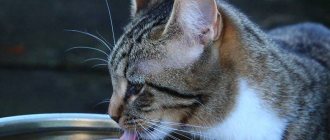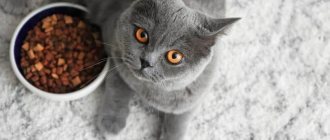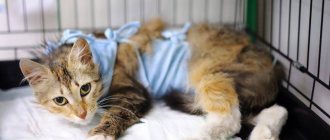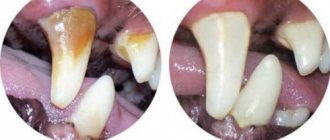Infectious rhinotracheitis in cats (feline herpes) is a dangerous disease of viral origin that affects the eyes and respiratory system. The virus affects cats of all age groups. Cats living in close proximity to infected pets, especially in kennels or shelters, are at greatest risk of contracting the virus.
Feline viral rhinotracheitis is caused by feline herpesvirus 1 (FHV-1) of the Herpesviridae family. It is also called "cat flu" or "feline pneumonia". Rhinotracheitis is not dangerous for humans; our diseases are caused by other viruses of the same family.
Epizootological data
Viral respiratory infections in cats are quite common. Both adults and small kittens with weakened immune systems are affected. The source of rhinotracheitis are infected cats and virus carriers. If a pregnant cat is not vaccinated, this can lead to intrauterine infection of the kittens. Recovered animals will be latent carriers of the herpes virus.
The infection most often affects young animals and weakened older animals. If the immune system copes with the infection, after 8-10 days the disease enters the latent phase: there is no discharge, the animal is outwardly healthy, but the virus lies dormant in its body and if the immune system is weakened, it can appear again.
Rhinotracheitis itself is not very dangerous, but if the animal is weakened, the damaged mucous membranes are attacked by bacteria and protozoa - mycoplasma and chlamydia, and this is what can lead to the pet’s blindness or even death. Such outcomes usually occur in very young kittens.
Vaccination will protect your pet if he has not yet had contact with the virus, and if he has already had contact with the virus, then vaccination will protect him from severe disease. The first vaccination is done in the first months of life (8-10 weeks), after 2 weeks it is repeated, then done after a year and revaccinated once every 2-3 years. This vaccination is carried out in combination with vaccinations against calicivirus and the most dangerous disease of cats - panleukopenia.
Course and symptoms
In addition to the respiratory and genital localization of the pathological process, other forms of lesions can be observed: nervous, enteral, abortive, enteral, articular, skin, dental. Depending on the prevailing symptoms, five clinical forms of the disease are distinguished, and isolated syndromes of damage to the eyes, joints and brain are rare.
The first symptom of RTI is high temperature
The first symptoms of the disease appear 2-10 days after infection. A sick animal's temperature rises sharply, sensitivity becomes dull, and breathing becomes more frequent. The animal is in a depressed state. Mucous discharge from the nose appears, initially light, and as the disease progresses, purulent. Fibrous formations form in the affected areas; after removal, ulcers are exposed.
Respiratory form of IRT
Respiratory forms of the disease primarily affect calves and young animals of both sexes, and less often adult livestock. During the neonatal period, the IRT virus causes bronchopneumonia, the disease is accompanied by digestive disorders (diarrhea), and occasionally arthritis. Complications such as keratoconjunctivitis and meningoencephalitis are possible.
RTI virus is rarely associated with arthritis in calves
Among the most characteristic symptoms of the respiratory form of the course:
- catarrhal discharge from the nose;
- hyperemia of the mucous membranes of the nasopharynx;
- cough;
- secretion of foamy saliva.
When the lungs are involved in the pathological process, bronchopneumonia develops with pronounced necrotic changes, blockage of bronchi of different sizes, asphyxia, and death are possible. Mortality – up to 20%. The respiratory form of the disease is the most severe; complications often develop against the background of damage to the respiratory system.
Ulcers on the nasal planum
At the age of up to 6 months, young animals may develop encephalitis. Sick calves can become aggressive, overexcited, and later develop convulsions, muscle tremors, depression, poor coordination of movements, and paralysis. Some animals become depressed.
Sick calves may develop paralysis
Adult, sexually mature animals develop IPV, the genital form of herpesvirus infection. This form of infection can occur hidden. With a clinically pronounced course, the mucous membranes of the vagina become inflamed with manifestations of a nodular rash. Elements of the rash turn into pustules, in place of which areas of erosion and ulcerative lesions appear.
Infectious pustular vaginitis in a cow
In bulls, the genital form occurs as balanoposthitis with manifestations of a nodular pink-red rash. The size of the rash elements is up to the size of a pinhead. When the reproductive system is damaged, sexual cycles are disrupted and long-term infertility is observed.
Rare manifestations of the disease
Skin lesions are more common in bulls. The pathological process involves the perianal region, perineum, skin at the root of the tail, on the scrotum and buttocks. In the affected areas, the hair thins greatly, up to complete baldness, and an eczema-like rash appears. The cutaneous form of the disease can be combined with the genital one.
Genital form of the disease in a bull
During pregnancy, the virus penetrates the placental barrier. Intrauterine infection in the early stages ends in the death of the embryo, in the later stages - fetal death, spontaneous abortion, and stillbirth.
Intrauterine infection of the fetus often ends in abortion
Sometimes cows develop acute mastitis. Surviving calves are severely weakened and die within a few days after birth. It is known that animals that have previously suffered from the disease in any other form are more prone to abortion. Due to complications after an abortion, death is possible.
Mastitis is one of the rather rare manifestations of the disease
How the virus is transmitted
Feline rhinotracheitis, also known as feline herpes virus, is easily transmitted to other cats if they come into contact with infected animals or share objects with them: bedding, bowls, toys. The virus is transmitted through secretions from the eyes, nose and trachea. Animals that have had contact with the virus are dangerous to others only during periods of exacerbation of the disease, when there are symptoms.
Although mild forms of feline rhinotracheitis go away on their own, seeing a veterinarian if you notice signs of this disease is necessary: firstly, it may be another disease that can be started, and secondly, the animal may require maintenance therapy or antibiotics.
Acute course of the disease
During the acute course of the disease in cats, the temperature rises greatly - up to 40 degrees, the animals become feverish.
Anorexia is also a symptom in this case .
After a few days , obvious frequent sneezing begins, the cat constantly drools, serous and later purulent conjunctivitis appears.
In the worst cases , the intestines suffer and constipation begins.
Nasal discharge becomes yellow or even grayish and stringy, but at first it may be normal clear and runny.
The bronchi suffer : the cat begins to cough, sometimes to the point of coughing up sputum, often accompanied by vomiting.
The nose becomes completely stuffy, making it difficult for the cat to breathe.
Acute rhinotracheitis lasts about two weeks.
Sores may appear in the mouth and nose In this condition, the cat refuses to drink, as a result of which it may develop dehydration.
With proper treatment, the cat recovers within a week.
And if treatment is delayed, rhinotracheitis becomes chronic.
Symptoms of rhinotracheitis
The active phase of the disease is indicated by the following symptoms:
- frequent sneezing;
- discharge from the nose and eyes;
- salivation;
- lethargy;
- weight loss;
- the eyes are constantly partially blocked by the third eyelid;
- inflammation of the conjunctiva of the eyes (conjunctivitis);
- keratitis (inflammation of the cornea causing blurred vision);
- decreased appetite;
- general malaise;
- loss of pregnancy.
The temperature during rhinotracheitis does not rise above 38.3-38.5 ° C - for cats it is like 37 ° C for us. If there is a fever, we are not talking about rhinotracheitis or not only about it. In this case, you need to see a doctor as quickly as possible.
When treating sick pets, your veterinarian will evaluate clinical signs and the presence of secondary infections, and prescribe medications to speed recovery and keep your pet alive.
Rhinotracheitis in animals: why you should choose our veterinary
When choosing a veterinary center that will care for your animal until the end, you should pay attention to many factors:
- How long has this institution been operating?
- Are there any highly specialized specialists?
- What kind of work experience do they have?
- How often is equipment updated?
- Availability of public transport.
- Possibility of calling a doctor at home at any time of the day.
All these factors should certainly attract the attention of the loving and caring owner of a furry ball who finds himself face to face with the illness of his most beloved creature. Don't be shy or afraid. Veterinary doctors will provide qualified assistance that will help your pet get back on all 4 paws as quickly as possible, overcome rhinotracheitis and feel the taste of life again. By contacting us for help, you will be pleasantly surprised by the speed and availability of highly specialized specialists (for example, an oncologist) who will help you understand the most complex and confusing situation. Does an ordinary veterinarian refer you to a surgeon? Calmly. You need to agree and go for an examination before it’s too late. A doctor will never rush tests for profit. Any direction is created for a specific purpose.
At the moment, medicine has come so far that those diseases that were previously considered fatal are now treated very easily and without problems.
Diagnosis of rhinotracheitis
Diagnosis of rhinotracheitis is not difficult. You just need to do swabs and carry out PCR diagnostics. But similar symptoms are caused by several other infectious diseases: calicivirosis, mycoplasmosis, chlamydia. It is impossible to suspect which of them caused discharge from the nose and eyes of a particular cat. Of course, calicivirus has other symptoms, but in mild cases they may not appear.
There is a specific treatment against chlamydia and mycoplasmosis, without which these diseases will not go away. Therefore, it is necessary to find out exactly what exactly your pet is sick with. To do this, they either take a PCR test for each of these infections separately, or a so-called “respiratory profile”: such a comprehensive analysis is offered by an increasing number of laboratories.
Carrying out the analysis makes sense only in the acute phase of the disease. What needs to be taken for analysis is not the discharge, but the epithelium of the mucous membrane, so the doctor first carefully removes the crusts with saline solution, and then runs a cotton swab across the conjunctiva. Flushes are taken from both eyes and from the nasal passages.
Diagnostics
The diagnosis is made on the basis of a clinic with mandatory laboratory testing of biomaterial.
Laboratory diagnosis is made on the basis of studies of discharge from the nasal cavities, vagina, eyes, prepuce, and aborted fetuses.
For pathological and anatomical diagnosis, material is taken from pieces of the trachea, lungs, lymph nodes, aborted fetuses, and testes.
Laboratory studies are based on the isolation of the virus in cell culture, followed by identification by RNGA, ELISA, and RN reactions.
When making a diagnosis, it is necessary to exclude: parainfluenza-3, viral diarrhea in calves, adenovirus infection, pasteurellosis, caliciverosis and chlamydia in cats.
Treatment of rhinotracheitis in cats
In mild cases of rhinotracheitis, treatment is not required; care is sufficient: cleaning the nose and eyes from crusts using a cotton pad soaked in saline solution. If the animal has a decreased appetite, more nutritious diets are selected, temporarily switched to canned food or pates, and the principle of fractional feeding is applied. Monitoring the pet’s condition is extremely important: if it gets worse, it is necessary to add medications.
It can be:
- antibiotics – if a secondary infection occurs or tests reveal concomitant infections;
- interferon - in a recurrent form, it is advisable to apply it topically (by instilling into the eyes and nose) 4-6 times a day at the very beginning of the disease, before it has time to develop;
- human drugs for the treatment of herpesvirus – for severe systemic lesions;
- in the absence of appetite - infusion (droppers) intravenously or subcutaneously. The last method is sufficient in most cases.
- vitamin preparations, especially ascorbic acid, help the animal’s body form a sufficient immune response;
- If you have a painful cough, humidifying the air will help, for example, pour hot water into the bath, wait until the room is saturated with steam, bring your pet there and stand for 10-15 minutes.
Learn more about the symptoms, diagnosis, treatment and prevention of infectious rhinotracheitis in animals.
What happens if rhinotracheitis is not treated?
Many careless owners think that rhinotracheitis is a completely harmless cold that can be left untreated. They are very wrong. If this is an insidious disease
If not cured in time, there may even be fatal consequences in the form of pneumonia, secondary infections, constipation, leukemia, viral immunodeficiency and other dangerous conditions that arise if rhinotracheitis is not treated in a timely manner. These fears often seriously worry owners.
Rhinotracheitis: how to care for a sick animal
The owner should not be afraid of infections, however, he should show maximum care to the animal:
- Despite the lack of appetite, the animal should not remain hungry. It must certainly receive semi-liquid food using a syringe.
- The place where the animal is located should be dry and warm, and drafts should not be allowed.
- To make breathing easier, you can give your cat steam inhalation.
- A calm, cozy environment will also help cure the disease as soon as possible.
- The tray and bowl should not only be washed regularly, but also disinfected.
- Rubbing your eyes will help prevent crusts from forming.
If the animal does not want to eat at all, then, for example, a favorite pate, fish, or meat will help stimulate the appetite.
Rhinotracheitis: possible prognosis for the course of the disease
Rhinotracheitis can be treated very successfully if promptly contacted by a veterinarian. However, the most difficult to treat is in a kitten or puppy who does not yet have the proper immunity. There is a huge
growths, ulcers, which are an invariable companion to any disease.
You need to get rid of them as soon as possible. They can significantly undermine the animal’s immune system in the shortest possible time. If crusts and growths on the eye are not eliminated, your pet may remain blind forever
. We are sure that no normal owner will be able to watch his pet suffer. Call a veterinarian to your home. This is a great solution if you don't want your pet to experience additional stress.
How not to harm a pet with rhinotracheitis
Human methods of treating runny nose and cough are completely unsuitable for animals. Although the owner’s hand sometimes reaches for vasoconstrictor drops, using them in this case is unacceptable: they dry out the nasal mucosa of pets and make it easier for them to be affected by additional infections.
You cannot treat a cough with drugs to thin sputum like ACC and Lazolvan: rhinotracheitis is a viral process, with which thick sputum simply does not form, but these drugs can facilitate the flow of liquefied mucus containing viruses from the trachea into the lungs. And then, instead of the relatively harmless rhinotracheitis, the veterinarian will have to deal with a much more formidable viral pneumonia, which threatens the death of the animal.
If your eyes are affected, you should absolutely not try to drip any drops! In this case, an examination by a veterinarian is simply necessary, since it is important to understand whether the cornea is too damaged. Most drops are very aggressive if they get inside the eyeball, and the animal can permanently lose vision.
Prevention of viral rhinotracheitis in cats
Preventative measures exist, and they are simple.
- Vaccinations. There is a vaccine against this disease that will effectively protect your pet. If you didn’t do it and missed this moment in time, and you have more than one cat, move the sick one away and isolate it. For the rest of you, get these vaccinations without delay. Their chance to stay healthy will increase many times over. Disinfection. Disinfect the room where the cat infected with rhinotracheitis was. Everything that your sick patient has come into contact with must be disinfected. Her dishes and other accessories too. It is best to use bleach or sodium hydroxide (sodium hydroxide). Remember that the virus is tenacious, so leave disinfectants on objects for at least half an hour. Strengthening the immune system. A strong, healthy cat with a strong “bastion” - immunity, always tuned against dangerous microflora, will most likely withstand the onslaught of the virus. He won't get sick. Balance the diet, stimulate mobility, and eliminate stress on the animal. There are preventive immunomodulators - use them. Especially if there is an outbreak of rhinotracheitis in your area. Do not allow your ward to come into contact with recently ill or homeless relatives. It's better to sunbathe on the balcony. It’s safer for you – it’s safer for him.
Treatment of rhinotracheitis in cats is not particularly difficult, but it does require patience. Stock up on it if you intend to help a little suffering creature. Just be patient for one to two weeks, following the instructions, and everything will work out. The eyes and nose will clear, inflammation in the mouth will disappear, and the respiratory system will return to normal. The owner of an animal is always a bit of a veterinarian. You will definitely succeed.
Treatment at home
Treatment at home involves simple rules that the pet owner must adhere to. Let's look at them in detail.
Home treatment for an infected animal:
- drink plenty of fluids (liquid should be at room temperature);
- fortified and high-calorie food (food should be warm);
- provide your pet with a cozy and warm place in the house;
- do not lower the temperature to 39.5 degrees.
Remember! If a sick cat refuses to eat, try feeding it in any way. Fasting will weaken the animal and can lead to aggravation of the disease.
If the cat completely refuses food, droppers are needed.
The causative agent of rhinotracheitis
The danger is that the cat can get sick even while at home. For example, the owner brought the infection from the street on the soles of his shoes or stroked someone else's infected cat while visiting. Also, a pet can catch the virus while walking or at an exhibition. After all, the disease is transmitted by airborne droplets.
The main causes of pet infection:
- communication with a carrier of the virus;
- Sharing toys, tray or utensils with an infected animal by a healthy cat.
Danger of the virus to people
Most experts say that a sick animal does not pose a danger to humans. People also get herpes, but of a completely different type. Rhinotracheitis is a seasonal disease in cats. A person also tends to get sick in the fall or spring.
So, if the owners and the cat caught a cold at the same time, it’s most likely just a coincidence. However, while there is a sick pet in the house, it is recommended to refrain from guests. These measures will help prevent the dangerous virus from being carried to another place and infecting other animals.
Consequences of the disease and incubation period
The incubation period - the time from infection to the appearance of the first symptoms - ranges from 3 to 12 days. The disease itself lasts 5-14 days. With a weakened immune system, advanced cases, or lack of proper treatment, the animal will develop complications. Rhinotracheitis is especially dangerous in kittens. It leads to severe damage to the eyeballs and often such animals require removal of an eye, or even both. Kittens severely affected by herpesvirus cannot always be saved. Therefore, for very small pets, a visit to the veterinarian is literally necessary “at the first sneeze.”
Rhinitis in cats affects the digestive system in 20% of cases. Diarrhea, constipation or vomiting may occur, which becomes chronic quite quickly, in which case the animal will require a lifelong diet.
Brief description of the disease
The source of the herpes virus is sick cats or carriers of the virus. The FHV-1 virus in such cats persists for a long time in the ganglia and neurons, and in the respiratory tract it is detected within 50 days after recovery. In stressful situations, with hypothermia, or a decrease in the body’s overall resistance (including during pregnancy, after sterilization or castration), the pathogen is activated and begins to multiply in lymphocytes. Symptoms of a mild respiratory illness appear, which last up to 2 weeks, in rare cases they become chronic.
The disease is widespread in the world, occurring in 50-75% of cats of all breeds and ages, but kittens and young cats under 1 year of age are more often infected. The virus is isolated from animals aged 6-12 months in 60% of cases, from 1 to 5 years – in 20%. The prevalence of the rhinotracheitis virus is seasonal, peaking in spring and autumn. The incubation phase of herpes disease lasts up to 10 days. Recovery can occur in 10-14 days.
The chronic course of the disease is complicated by intestinal atony, constipation, bronchitis, pneumonia, inflammation of the cornea, which leads to poor vision and damage to the nervous system. Most animals that have had acute rhinotracheitis become carriers of the virus. Cats can excrete the virus in milk, urine and feces for a long time - for a year and a half.
With ulcerative lesions of the oral mucosa and pneumonia, deaths are possible. Among adult animals, the mortality rate is low. Most often, small kittens and animals with weakened immune systems die due to dehydration and secondary infection. The immunity acquired as a result of the disease in a cat is short-lived - up to 3 months. In 36% of cases of respiratory diseases, viral rhinotracheitis occurs together with calcivirosis.
Pregnant cats with rhinotracheitis experience spontaneous abortions. Newborn kittens can acquire weak immunity through their mother's milk. The offspring of a sick cat is often born dead or sick (congenital deformities, kittens without hair).
The disease is typical only for representatives of the cat family and is not dangerous for dogs or people.











